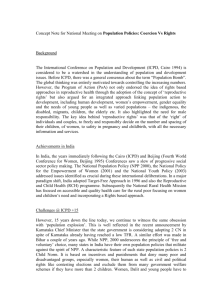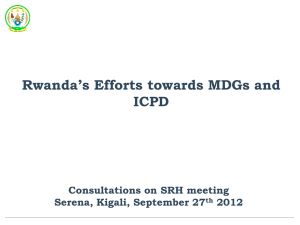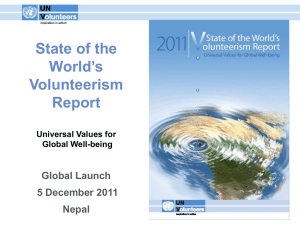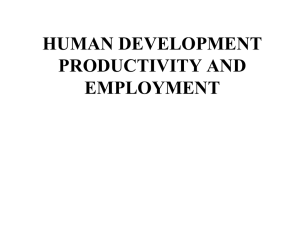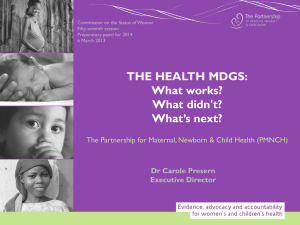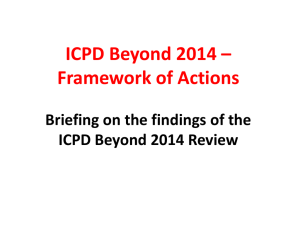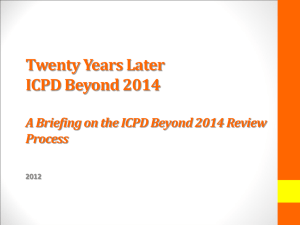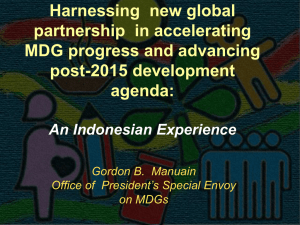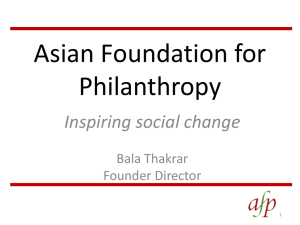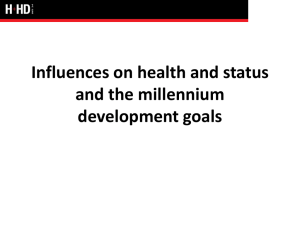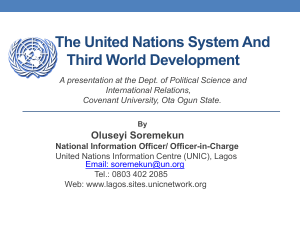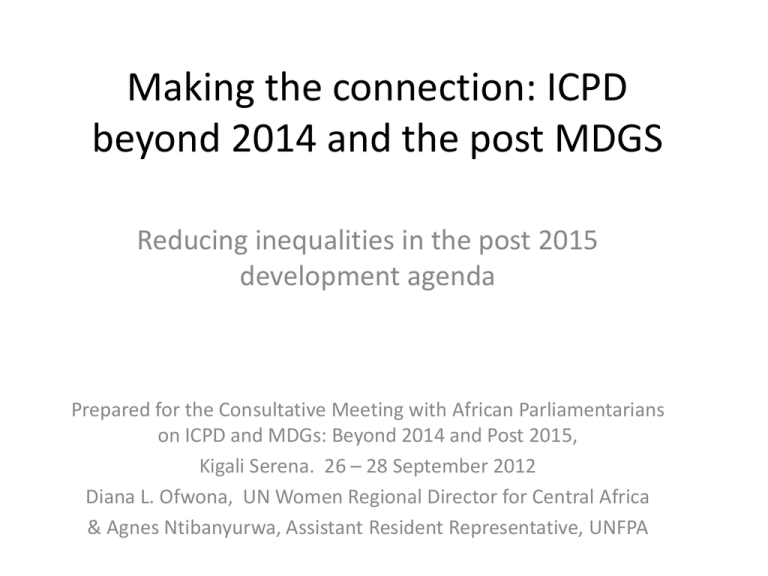
Making the connection: ICPD
beyond 2014 and the post MDGS
Reducing inequalities in the post 2015
development agenda
Prepared for the Consultative Meeting with African Parliamentarians
on ICPD and MDGs: Beyond 2014 and Post 2015,
Kigali Serena. 26 – 28 September 2012
Diana L. Ofwona, UN Women Regional Director for Central Africa
& Agnes Ntibanyurwa, Assistant Resident Representative, UNFPA
Outline
•
•
•
•
Background ICPD and MDG: Looking back
ICPD and MDG: how are they linked?
The centrality of MDG 3
Family Planning and its contribution to
reducing equalities and achieving the MDGs
• Beyond 2014 and post 2015 development
agenda: where to put focus
• Conclusion
I. Background ICPD and MDG: Looking back
• ICPD is the International Conference on Population and
Development. It was held in Cairo in 1994, where a
Programme of Action (PoA) was adopted, by
consensus, by 179 countries to improve the quality of
life for all people across the world.
• ICPD - a milestone in the history of population and
development, as well as in the history of women's
rights.
• The world agreed that population is not just about
counting people, but about making sure that every
person counts.
ICPD con’t
• Consensus was reached that the equality and
empowerment of women is a global priority. It
approached this not only from the perspective of
universal human rights, but also as an essential
step towards eradicating poverty and stabilizing
population growth.
• A woman’s ability to access reproductive health
and rights is cornerstone of her empowerment.
• It is also the key to sustainable development.
ICPD Programme of Action
1. Provide universal access to family planning and
sexual and reproductive health services and
reproductive rights;
2. Deliver gender equality, empowerment of
women and equal access to education for girls;
3. Address the individual, social and economic
impact of urbanization and migration;
4. Support sustainable development and address
environmental issues associated with population
changes
The Millennium Development Goals
At the Millennium Summit in 2000, the world community was
beckoned to commit itself to meeting eight development
goals:
Making the connection: ICPD
beyond 2014 and the post MDGS
Reducing inequalities in the post 2015
development agenda
Prepared for the Consultative Meeting with African Parliamentarians
on ICPD and MDGs: Beyond 2014 and Post 2015,
Kigali Serena. 26 – 28 September 2012
Diana L. Ofwona, UN Women Regional Director for Central Africa
II. ICPD and MDG: how are they linked?
Five out of 8 MDGs demonstrate a clear overlap with the ICPD PoA :
(a)
(b)
(c)
(d)
(e)
goal 2: achieve universal primary education;
goal 3: promote gender equality and empower women;
goal 4: reduce child mortality;
goal 5: improve maternal health; and
goal6: combat HIV/AIDS, malaria and other diseases.
Although not similar in scope and function, two other MDGs are also
closely linked to the ICPD since they, too, are concerned with
population and development issues: (a) goal 1: eradicate extreme
poverty and hunger; and (b) goal 7: ensure environmental
sustainability, The eighth MDG: global partnership for development) is
also reflected in the ICPD PoA. Both declarations recognize the
importance of partnerships in achieving development goals.
III. The centrality of MDG 3
In recent reports, OECD, UNESCO, UNDP, the World Bank and
ODI all stress the importance of achieving the third MDG
(Gender Equality) as a prerequisite to progress on the other
MDGs.
An OECD research paper (2011) demonstrated that women’s
access to resources is strongly co-related with child health
outcomes; countries where women lack any right to own land
have on average 60% more malnourished children.
A similar co-relation was found between levels of discrimination
against women and maternal mortality.
IV. Family Planning and its contribution to
reducing equalities and achieving the MDGs
MDG 1: Eradicate extreme poverty and hunger
Family planning contributes to alleviating poverty and accelerating
socio-economic development.
With fewer, healthier children to provide for, families are less likely to
become destitute (as they would only have as many children as
they could realistically cater for).
They are also better able to feed and provide health care for their
children, which creates a healthier and more productive workforce
that can contribute to overall economic growth of the nation.
On the national level, rapid population growth resulting from high
levels of unmet needs in FP often outstrips economic growth and
undermines a country’s ability to offer adequate educational, health,
and other social services to its people.
MDG 2 : Achieve universal primary education
Family planning can help ensure
that all children go to school.
Families are more likely to be able to
educate their children if they have
smaller families; for example, some
girls are forced to drop out of school
early to care for younger siblings.
Girls and young women may
also be forced to leave school
early if they get pregnant.
Education
Women who have
completed at least
primary education are
said to be more likely to
be able to negotiate
safe sex
MDG 3: Promote gender equality and
empower women
Family planning promotes gender equality.
Women have greater opportunities for education,
training, and employment when they can control
their fertility. This in turn can increase their
financial security, decision-making power in the
household and status in the community.
MDG 4: Reduce child mortality
Family planning can reduce infant mortality by
one-fifth to one-third or even more in some settings.
Spacing births 36 to 60 months apart reduces
malnutrition as well as neonatal and infant mortality.
• Infant and child mortality are highest for the
youngest mothers and after closely spaced births
• Frequent births reduces the provision of quality care
to children
MDG 5 : Improve maternal health
Family planning reduces maternal mortality
in three ways:
1.
It decreases the total number of
pregnancies, each of which places a
woman at risk.
2.
It prevents pregnancies that are
unwanted and hence more likely to end
in unsafe abortions, which contribute to
one in eight maternal deaths.
3.
It reduces the proportion of births that
are at greater risk of complications
because of the mother’s age, parity, or
birth spacing.
MDG 6: Combat HIV/AIDS, malaria and other
diseases
Family planning can slow the spread
of HIV/AIDS.
Condom use simultaneously provides
higher chances of preventing HIV
transmission and unwanted pregnancy.
Contraceptives also enable HIV-positive
women to prevent unwanted
pregnancies.
MDG 7: Ensure environmental sustainability
Family planning can indeed help protect
the environment by reducing
population growth and thus reducing
the pressures it places on natural
resources, including arable land, fresh
water, fuel, etc.
The world’s population reached 7 billion
on 31 October 2011, with the ensuing
consequences on the environment
and other resources.
Environment
MDG 8: Develop a global partnership for
development
• Sustainable access to effective
essential drugs and medicines is
a problem for women and men
in many parts of the world.
• Global partnerships can help to
secure adequate supplies of
essential reproductive health
drugs and commodities for poor
countries (including
contraceptives, testing kits and
treatments for HIV and other
STIs).
V. ICPD Beyond 2014 and Post 2015
• Member states have already called for a special event to be
held in 2013 to take decisions on a post 2015 (during the 68th
session of the General Assembly to follow up the 2010 MDG
summit).
• (In Claire Melamed, ODI. 2012) – The key question beyond
ICPD 2014 and post 2015 is whether the new agreement to be
reached, will again be about tackling extreme poverty or
whether it will be about defining , measuring and giving
incentives for progress on development in a broader sense
which encompasses all countries and people.
ICPD Beyond 2014 and Post 2015 contd…
• One way forward is to refocus on inequalities as a new
development framework that closely reflect the realities of poverty
and the factors that drive it.
• Addressing particular inequalities directly would be more likely to
lead to a greater focus on the dynamics of power and exclusion,
which underlie poverty. It also makes sense in that it is the one
stumbling block to sustainable development.
• In instances where the universal targets of the MDGs and the
objectives of the ICPD have been met, an agreement could extend
to addressing broader inequalities and relative poverty. (Focusing
on, for example, narrowing gaps in educational attainment and
health outcomes between groups.
CONCLUSION
• Progress has been achieved both with respect to the
ICPD and the MDGs.
• Beyond 2014 and post 2015, discussion should focus
on reviewing what worked and what did not work in
ICPD and MDGs
• Carrying forward new and lingering issues that need
further reflection e.g. inequality, climate change,
food and energy security, environmental
degradation, demographic trends, youth, peace and
security and good governance.
• The Millennium Declaration remains relevant beyond
2014 and post 2015.
THANK YOU

